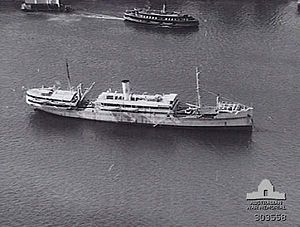
A hospital ship is a ship designated for primary function as a floating medical treatment facility or hospital. Most are operated by the military forces of various countries, as they are intended to be used in or near war zones. In the 19th century, redundant warships were used as moored hospitals for seamen.
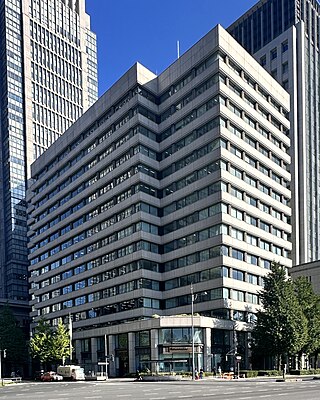
The Nippon Yusen Kabushiki Kaisha, also known as NYK Line, is a Japanese shipping company. The company headquarters are located in Chiyoda, Tokyo, Japan. It operates a fleet of over 800 ships, which includes container ships, tankers, bulk and woodchip carriers, roll-on/roll-off car carriers, reefer vessels, LNG carriers, and cruise ships. It is a member of the Ocean Network Express and Mitsubishi Group.

The sixth USS Relief (AH-1), the first ship of the United States Navy designed and built from the keel up as a hospital ship, was laid down 14 June 1917 by the Philadelphia Navy Yard; launched 23 December 1919; and commissioned 28 December 1920 at Philadelphia, Commander Richmond C. Holcomb, Medical Corps, USN, in command.

The second USS Solace (AH-5) was built in 1927 as the passenger ship SS Iroquois by the Newport News Shipbuilding and Drydock Co., Newport News, Virginia. The liner was acquired by the Navy from the Clyde Mallory Steamship Line on 22 July 1940, renamed Solace (AH-5); converted into a hospital ship at the Atlantic Basin Iron Works, Brooklyn, N.Y., and was commissioned on 9 August 1941, Captain Benjamin Perlman in command.

USS Hope (AH-7) was a Comfort-class hospital ship launched under Maritime Commission contract by Consolidated Steel Corporation, Wilmington, California, 30 August 1943; sponsored by Miss Martha L. Floyd; acquired by the Navy the same day for conversion to a hospital ship by U.S. Naval Dry Dock, Terminal Island, Calif.; and commissioned 15 August 1944.
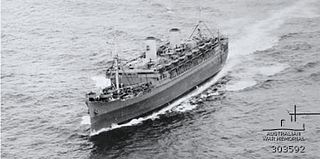
SS Mariposa was an ocean liner launched in 1931, one of four ships in the Matson Lines "White Fleet", which included SS Monterey, SS Malolo, and SS Lurline. She was later renamed SS Homeric.

SS President Coolidge was an American luxury ocean liner that was completed in 1931. She was operated by Dollar Steamship Lines until 1938, and then by American President Lines until 1941. She served as a troopship from December 1941 until October 1942, when she was sunk by mines in Espiritu Santo in the New Hebrides at the Espiritu Santo Naval Base, part of current-day Vanuatu. President Coolidge had a sister ship, SS President Hoover, completed in 1930 and lost when she ran aground in a typhoon in 1937.

USS Samaritan (AH-10) was a hospital ship that served with the US Navy in World War II. Prior to that, she served as a US Navy transport ship under the name USS Chaumont (AP-5).
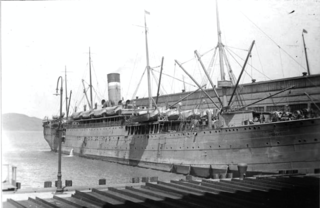
USAT Thomas was a United States Army transport ship purchased on 26 July 1898 for Spanish–American War service. Thomas served with the Army Transport Service (ATS) until retired in 1929.
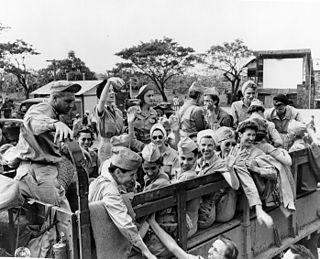
The Angels of Bataan were the members of the United States Army Nurse Corps and the United States Navy Nurse Corps who were stationed in the Philippines at the outset of the Pacific War and served during the Battle of the Philippines (1941–1942). When Bataan and Corregidor fell, 11 navy nurses, 66 army nurses, and 1 nurse-anesthetist were captured and imprisoned in and around Manila. They continued to serve as a nursing unit while prisoners of war. After years of hardship, they were finally liberated in February 1945.

USAT McClellan was a United States Army transport ship that saw service during the Spanish–American War and World War I. She also participated in the occupation of Veracruz in 1914.

Naval Base Subic Bay was a major ship-repair, supply, and rest and recreation facility of the Spanish Navy and subsequently the United States Navy located in Zambales, Philippines. The base was 262 square miles (680 km2), about the size of Singapore. The Navy Exchange had the largest volume of sales of any exchange in the world, and the Naval Supply Depot handled the largest volume of fuel oil of any navy facility in the world. The naval base was the largest overseas military installation of the United States Armed Forces, after Clark Air Base in Angeles City was closed in 1991. Following its closure in 1992, it was transformed into the Subic Bay Freeport Zone by the Philippine government.
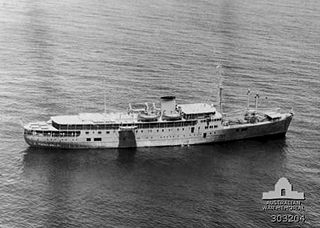
Don Isidro, delivered in 1939, was the second and larger of two Krupp built motor ships of De La Rama Steamship Company, Iloilo, Philippines in inter-island service. The ship was under charter by the United States Army as a transport during the Japanese invasion of the Philippines. As defending forces became cut off from supply by the Japanese blockade Don Isidro was one of eight ships, only three of which were successful, known to make an attempt to run the blockade. In that attempt, under her captain Rafael J. Cisneros, Don Isidro became involved in the 19 February Japanese attack on Darwin, Australia where, though not in the port, she was strafed, bombed and left off Bathurst Island burning with all lifeboats destroyed. The captain attempted to make land when she grounded about three miles off Melville Island to which survivors swam. Of the sixty-seven crew and sixteen soldiers aboard eleven of the crew and one soldier were killed or missing. Survivors were rescued by HMAS Warrnambool, taken to Darwin, treated at the hospital and then awaited orders at the 147th Field Artillery camp.

Don Esteban, delivered in 1936, was the first and smaller of two Krupp built motor ships of the De La Rama Steamship Company, Iloilo, Philippines in inter-island service. The ship was under a bareboat charter by the United States Army as a transport on 30 October 1941 for use in pre positioning U.S. Army Air Corps (USAAC) fuel and munitions in the southern Philippines, Netherlands East Indies, Singapore and Australia. After the Japanese invasion of the Philippines she evacuated personnel from the Army headquarters, including General MacArthur, from Manila to Corregidor on Christmas Eve, 1941. The ship was lost off Mindoro on 2 March 1942 while continuing its supply missions.
The following index is provided as an overview of and topical guide to Wikipedia's articles on recreational dive sites. The level of coverage may vary:

America Maru was the second of three high speed passenger liners built for the Oriential Steamship Company. Converted into an armed merchantman during the Russo-Japanese War of 1904–1905, she played a crucial role in the Battle of Tsushima. Although used as a hospital ship during the early part of World War II, she had been chartered by the Imperial Japanese Navy as a transport in 1943, and was sunk by the United States Navy in 1944 with great loss of civilian lives.

Recreational dive sites are specific places that recreational scuba divers go to enjoy the underwater environment or for training purposes. They include technical diving sites beyond the range generally accepted for recreational diving. In this context all diving done for recreational purposes is included. Professional diving tends to be done where the job is, and with the exception of diver training and leading groups of recreational divers, does not generally occur at specific sites chosen for their easy access, pleasant conditions or interesting features.

SS Warrimoo was a passenger and refrigerated cargo liner that was launched in 1892 in England for Australian owners, was later owned by two of New Zealand's foremost shipping companies, and finally belonged to a Singaporean company.
Sternberg General Hospital or Department Hospital, Manila P was a United States Military Hospital in Manila in the Philippines during the early part of the 20th century. The hospital was renamed after George Miller Sternberg on June 26, 1920.

Naval Base Manila, Naval Air Base Manila was a major United States Navy base south of the City of Manila, on Luzon Island in the Philippines. Some of the bases dates back to 1898, the end of the Spanish–American War. Starting in 1938 civilian contractors were used to build new facilities in Manila to prepare for World War II. Work stopped on December 23, 1941, when Manila was declared not defendable against the Empire of Japan southward advance, which took over the city on January 2, 1942, after the US declared it an open city. US Navy construction and repair started in March 1945 with the taking of Manila in the costly Battle of Manila ending on March 2, 1945. Naval Base Manila supported the Pacific War and remained a major US Naval Advance Base until its closure in 1971.
